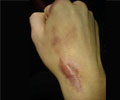Growing abdominal gunshot and stab wounds events are handled without needless operations, states study published by BJS, the British Journal of Surgeryin the January Trauma Supplement.

They focused on patients aged 16 years plus who survived long enough to be admitted to one of the 378 level one or two trauma centres for at least 24 hours. Just over half of the 25,737 patients (51%) had stab wounds and the remainder had gunshot wounds.
The study found that just over 22% of the gunshot wounds were treated using selective non-operative management (SNOM), together with just under 34% of stab wounds. The remainder of the surviving patients received laparotomy surgery.
"SNOM rates for stab wounds increased by 50% between 2002 and 2008 and rates for gunshot injuries increased by 28%" says co-author Dr Adil H Haider, associate professor of surgery and co-director of the Center for Surgery, Trials and Outcomes Research at Johns Hopkins. "This correlated with a decrease in the number of non-therapeutic laparotomies (NTL).
"In most instances, failed SNOM was associated with increased death rates, underlining the importance of careful patient selection and protocols to reduce failure rates. However, it is important to point out that failure rates fell for both injuries during the seven-year study period and that successful SNOM was associated with shorter hospital stays."
Key findings of the study included:
Advertisement
- SNOM rates averaged 22% during the study period, increasing by 28% from 19% to 24% between 2002 and 2008.
- During the same time period, the trend for NTL showed a strong negative correlation with SNOM (r= -0.70), decreasing by 9% from 19% to 17%.
- Failure rates fell from 33% to 20% over the study period - a reduction of 37% - and just over three-quarters of those failed within 24 hours. The percentage of failed SNOM patients who went on to have surgery was almost the same as the percentage operated on immediately (19% versus 18% respectively).
- Just under 2% of the 12,707 patients with gunshot wounds died from their injuries. After adjusting for demographics, injury severity and clinical variables, patients who failed SNOM were four-and-a-half times more likely to die than those successfully managed without surgery.
- Average hospital stays for successful SNOM patients were approximately six days, compared with 13 days for patients who had surgery and 14 days for the patients who failed SNOM.
- Gunshot victims were most likely to be male (87%), African American (52%) and aged between 16 and 45 (89%), with an average age of 30.
Stab wounds
- SNOM rates averaged 34% over the study period, increasing by 50% from 24% to 37% between 2002 and 2008.
- During the same time period, the rate of NTL showed a strong negative correlation with SNOM (r= -0.6), decreasing by 22% from 41% to 32%.
- Failure rates fell from 29% to 20% over the study period – a reduction of 33% - and 87% of those patients were operated on within 24 hours of presenting to the trauma centre.
- Less than half a per cent of the 13,030 patients with stab wounds died from their injuries. After adjusting for demographics, injury severity and clinical variables, patients who failed SNOM were almost ten times more likely to die than those successfully managed without surgery.
- Average hospital stays for successful SNOM patients were approximately four days, compared with seven days for the patients who has surgery and eight days for the patients who failed SNOM.
- Stabbing victims were most likely to be male (85%), white (38%) and aged 16 to 45 (80%), with an average age of 34.
Advertisement
"The results show that SNOM has a success rate of up to 80% in select patients, improved diagnostic imaging has made it easier to identify suitable patients and use of the technique has become more widespread. And they demonstrate that correctly selecting patients for non-operative management leads to shorter hospital stays, better outcomes and reduced pressure on healthcare budgets.
"However they also show that SNOM failure, which is most common in patients with severe injuries, those needing blood transfusions and those with spleen injuries, is independently associated with increased death rates and longer hospital stays."
Source-Eurekalert













